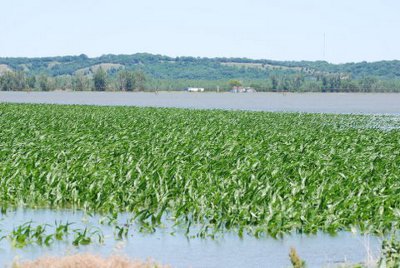Post-flood vegetable likely to be risky
Gazette Introductory Note: The article raises the related question of how much produce from flooded fields is sold in public markets. –-Hardly Waite.
If you’re cleaning up your vegetable garden after the flood waters recede, consider the safety of eating produce from the garden. If rain, and only rain, fell on the garden everything is fine. But if your vegetables were touched by by or near floodwater, your produce is risky-to-dangerous to consume.
Floodwaters can contain sewage, pollutants such as oil, gasoline, solvents, etc., bacteria and parasites such as Giardia, Cryptosporidium, E. coli, Shigella, the virus for Hepatitis A, and a host of other unsavory contaminants. Young children, seniors, pregnant women and people with compromised immune systems are at highest risk for serious effects from consuming contaminated food and should not eat any produce that was in or near floodwater.
In every case where the edible portion of the plant came into contact with floodwater — submerged or splashed — there is risk, regardless of whether the plant was above or below ground. In many cases, there is no effective way for washing the contaminants off of the produce.
To help you sort through what to do for crops that were near floodwaters, here are quick tips:
All crops eaten raw should be discarded, such as lettuce, mustards, spinach, cabbage, collards, Swiss chard, arugula, or micro greens. Soft fruits such as strawberries, raspberries, or blackberries as well as leafy vegetables such as spinach, chard, beet tops, or kale may be impossible to clean well and must be cooked before eating; avoid eating them raw. Because rain or sprinklers can splash contaminated soil back onto these plants and contaminants can become embedded in the leaves, stems, petioles, etc., the area is not safe for growing for 90 days, minimum.
Root crops, including carrots, radishes, parsnips, beets, or potatoes should be washed and rinsed in clean, potable (safe for drinking) water, sanitized in a dilute bleach solution, and then rinsed in potable water. They should also be peeled and cooked before consuming.
Make your sanitizing solution by mixing a scant tablespoon of food grade bleach, without fragrances or thickeners, to one gallon of potable water. Wash the produce with clean, potable water, using a vegetable brush to clean in crevices. Rinse, then dip into the sanitizing solution for two minutes, then rinse in clean water.
Peas, beans, tomatoes, peppers, eggplant, summer squash and other soft skinned crops that were present during the flood should be discarded. Winter squash, winter melons, and pumpkins, with their thick rinds, can be washed and rinsed in potable water, then sanitized in the dilute bleach solution described for root crops, and rinsed.
Questions on stage of plant growth versus potential for contamination can be summed up in this very good Purdue University response from Liz Maynard, Regional Extension Specialist, Commercial Vegetable and Floriculture Crops: Risks can be described as follows:
Edible portion of crop present: Very High Risk. Fresh produce is considered adulterated.
Plant emerged, edible portion not present: High Risk. The potential presence of microorganisms in the plant as well as in the soil could result in indirect contamination of the crop post flooding (splashing onto plant, etc.).
Planted but not emerged: Still High Risk for reasons given above from post flooding contamination in soil.
Pre-planting: Moderate Risk.
Soil contamination may be as dangerous as that of uncomposted manure. Tilling in the soil and a minimum of 90 days between the recession of waters and harvest are needed to reduce this risk from pathogens, but recovering soil from chemical pollutants may take longer.
To protect crops and areas not directly touched by floodwater, wash your hands before and after you’re in the garden, leave your garden shoes just outside your door, and change out of clothing you wore to work the vegetable patch.
For more information on post-flood issues, visit the Colorado State University Extension website atextension.colostate.edu/boulder/index.shtml orhttp://emergency.cdc.gov/disasters/disease/infectious.asp
Source: Daily Camera





